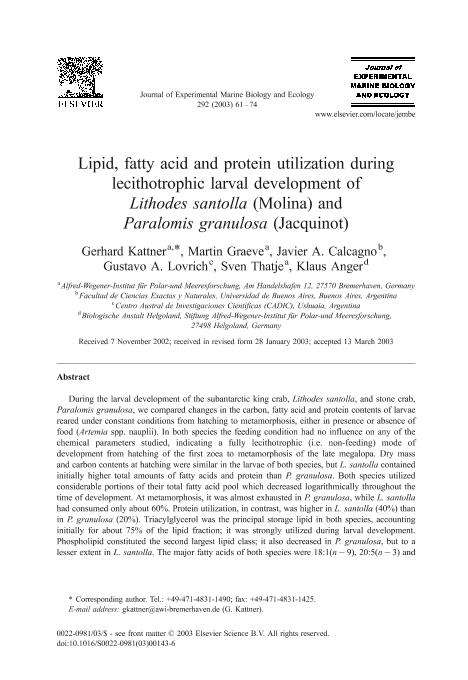Mostrar el registro sencillo del ítem
dc.contributor.author
Kattner, Gerhard
dc.contributor.author
Graeve, Martin

dc.contributor.author
Calcagno, Javier Ángel

dc.contributor.author
Lovrich, Gustavo Alejandro

dc.contributor.author
Thatje, Sven
dc.contributor.author
Anger, Klaus
dc.date.available
2020-01-15T20:32:47Z
dc.date.issued
2003-07
dc.identifier.citation
Kattner, Gerhard; Graeve, Martin; Calcagno, Javier Ángel; Lovrich, Gustavo Alejandro; Thatje, Sven; et al.; Lipid, fatty acid and protein utilization during lecithotrophic larval development of Lithodes santolla (Molina) and Paralomis granulosa (Jacquinot); Elsevier Science; Journal of Experimental Marine Biology and Ecology; 292; 1; 7-2003; 61-74
dc.identifier.issn
0022-0981
dc.identifier.uri
http://hdl.handle.net/11336/94830
dc.description.abstract
During the larval development of the subantarctic king crab, Lithodes santolla, and stone crab, Paralomis granulosa, we compared changes in the carbon, fatty acid and protein contents of larvae reared under constant conditions from hatching to metamorphosis, either in presence or absence of food (Artemia spp. nauplii). In both species the feeding condition had no influence on any of the chemical parameters studied, indicating a fully lecithotrophic (i.e. non-feeding) mode of development from hatching of the first zoea to metamorphosis of the late megalopa. Dry mass and carbon contents at hatching were similar in the larvae of both species, but L. santolla contained initially higher total amounts of fatty acids and protein than P. granulosa. Both species utilized considerable portions of their total fatty acid pool which decreased logarithmically throughout the time of development. At metamorphosis, it was almost exhausted in P. granulosa, while L. santolla had consumed only about 60%. Protein utilization, in contrast, was higher in L. santolla (40%) than in P. granulosa (20%). Triacylglycerol was the principal storage lipid in both species, accounting initially for about 75% of the lipid fraction; it was strongly utilized during larval development. Phospholipid constituted the second largest lipid class; it also decreased in P. granulosa, but to a lesser extent in L. santolla. The major fatty acids of both species were 18:1(n - 9), 20:5(n - 3) and 16:0 as well as, in lower proportions, 18:1(n - 7), 22:6(n - 3), 16:1(n - 7) and 18:0. Monounsaturated fatty acids represented the dominant group in L. santolla, whereas P. granulosa contained similar amounts of mono- and polyunsaturated fatty acids. In L. santolla, monounsaturated fatty acids, especially 16:1(n - 7), were preferentially utilized as compared to polyunsaturates. Due to a particularly strong lipid utilization in P. granulosa, all individual fatty acids were largely depleted at metamorphosis, showing similar extents of consumption. L. santolla had higher initial lipid and protein stores that seem to be used more economically as compared to P. granulosa. © 2003 Elsevier Science B.V. All rights reserved.
dc.format
application/pdf
dc.language.iso
eng
dc.publisher
Elsevier Science

dc.rights
info:eu-repo/semantics/openAccess
dc.rights.uri
https://creativecommons.org/licenses/by-nc-sa/2.5/ar/
dc.subject
FATTY ACIDS
dc.subject
LARVAL DEVELOPMENT
dc.subject
LECITHOTROPHY
dc.subject
LIPIDS
dc.subject
LITHODIDAE
dc.subject
PROTEIN
dc.subject.classification
Otros Tópicos Biológicos

dc.subject.classification
Ciencias Biológicas

dc.subject.classification
CIENCIAS NATURALES Y EXACTAS

dc.title
Lipid, fatty acid and protein utilization during lecithotrophic larval development of Lithodes santolla (Molina) and Paralomis granulosa (Jacquinot)
dc.type
info:eu-repo/semantics/article
dc.type
info:ar-repo/semantics/artículo
dc.type
info:eu-repo/semantics/publishedVersion
dc.date.updated
2020-01-15T19:04:30Z
dc.journal.volume
292
dc.journal.number
1
dc.journal.pagination
61-74
dc.journal.pais
Países Bajos

dc.journal.ciudad
Amsterdam
dc.description.fil
Fil: Kattner, Gerhard. Alfred-wegener-institut Helmholtz-zentrum Für Polar- Und Meeresforschung; Alemania
dc.description.fil
Fil: Graeve, Martin. Alfred-wegener-institut Helmholtz-zentrum Für Polar- Und Meeresforschung; Alemania
dc.description.fil
Fil: Calcagno, Javier Ángel. Universidad de Buenos Aires. Facultad de Ciencias Exactas y Naturales; Argentina. Consejo Nacional de Investigaciones Científicas y Técnicas; Argentina
dc.description.fil
Fil: Lovrich, Gustavo Alejandro. Consejo Nacional de Investigaciones Científicas y Técnicas. Centro Austral de Investigaciones Científicas; Argentina
dc.description.fil
Fil: Thatje, Sven. Alfred-wegener-institut Helmholtz-zentrum Für Polar- Und Meeresforschung; Alemania
dc.description.fil
Fil: Anger, Klaus. Alfred-wegener-institut Helmholtz-zentrum Für Polar- Und Meeresforschung; Alemania
dc.journal.title
Journal of Experimental Marine Biology and Ecology

dc.relation.alternativeid
info:eu-repo/semantics/altIdentifier/url/https://www.sciencedirect.com/science/article/pii/S0022098103001436
dc.relation.alternativeid
info:eu-repo/semantics/altIdentifier/doi/https://doi.org/10.1016/S0022-0981(03)00143-6
Archivos asociados
